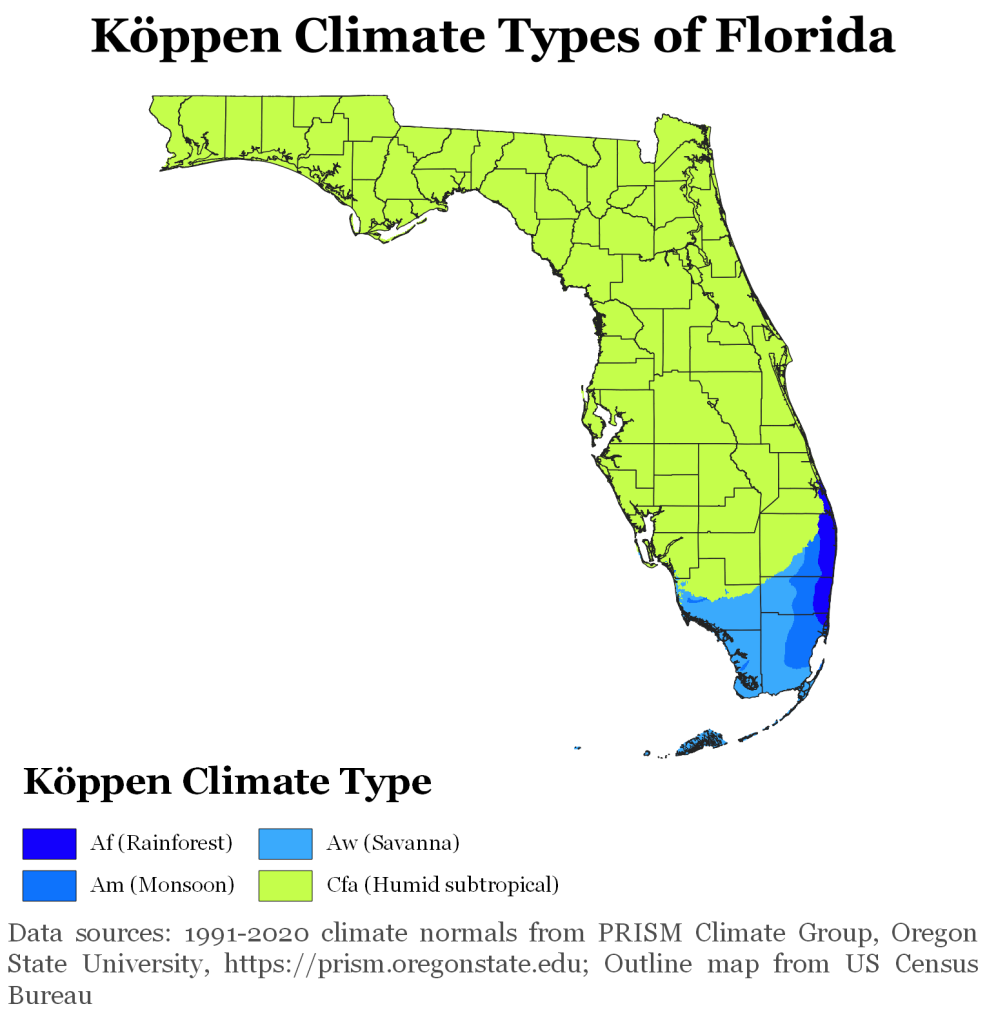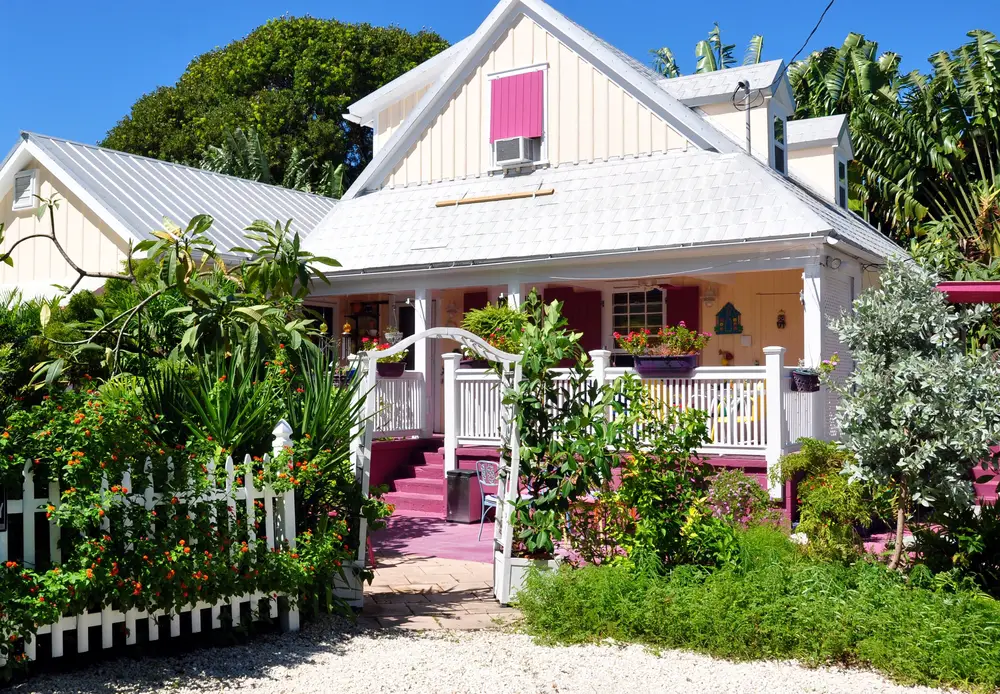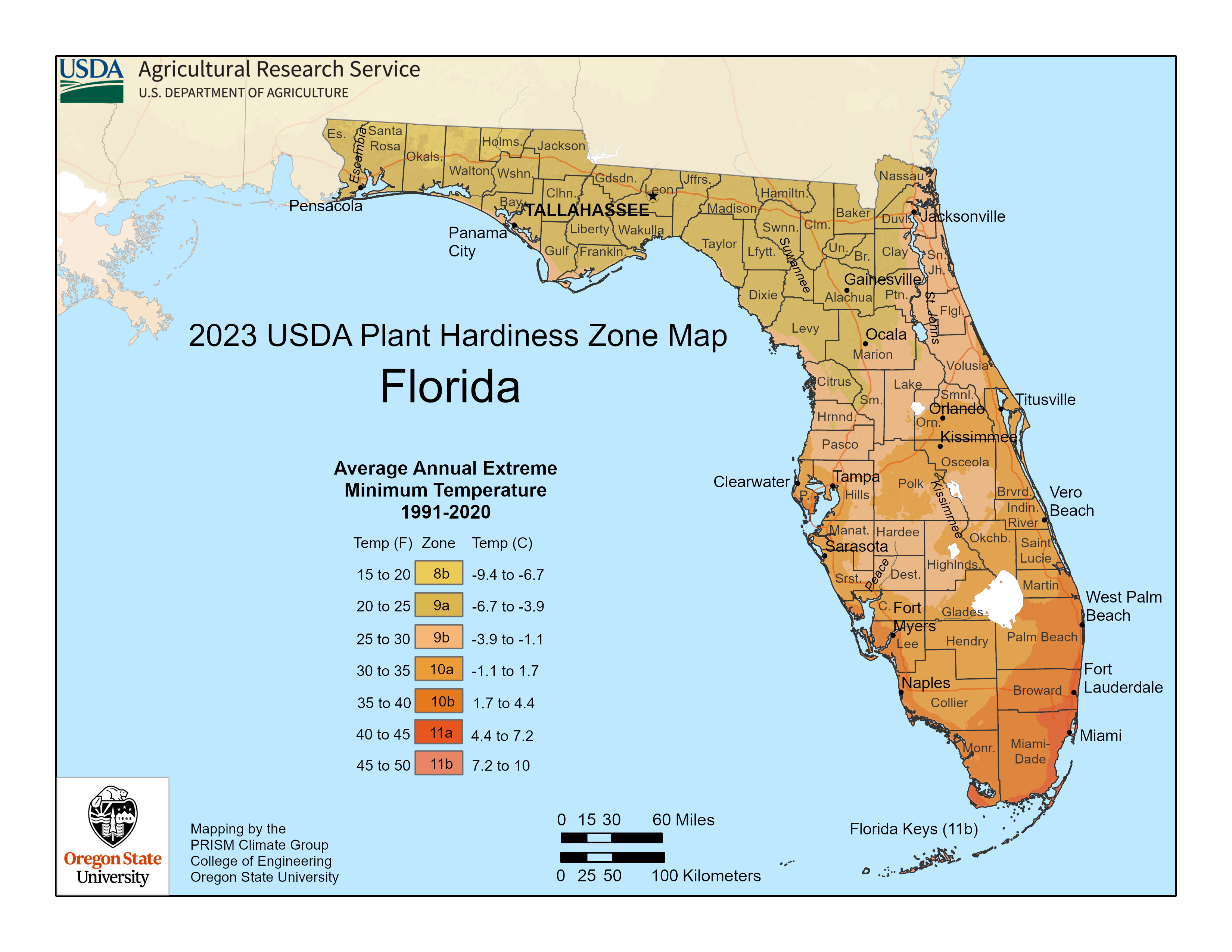Florida Plant Hardiness Zones
| USDA Hardiness Zone | Average Minimum Extreme Winter Temperature Range Fahrenheit (°F) Celsius (°C) | Average Last Frost Date Range In Spring (Beginning Of The Growing Season) | Average First Frost Date Range In Autumn (End Of The Growing Season) |
|---|---|---|---|
| 8b | 15°F to 20°F -9.4°C to -6.7°C | Mid to late February | Mid to late November |
| 9a | 20°F to 25°F -6.7°C to -3.1°C | Early to mid-February | Early to mid-December |
| 9b | 25°F to 30°F -3.8°C to -1.1°C | Mid to late January | Early to mid-December |
| 10a | 30°F to 35°F -1.1°C to 1.7°C | Early to mid-January | Mid to late December |
| 10b | 35°F to 40°F 1.7°C to 4.4°C | Early to mid-January | Early to mid-January |
| 11a | 40°F to 45°F 4.4°C to 7.2°C | Frost-free year round | Frost-free year round |
| 11b | 45°F to 50°F 7.2°C to 10°C | Frost-free year round | Frost-free year round |
Florida Growing Conditions
General Climate

Florida is divided into two major growing climates. The northern and central parts of the state are humid subtropical, while the south is tropical. This means the majority of the state experiences mild, short winters with long, hot summers. This is optimal for longer growing seasons with more plant diversity.
The south is broken up into three smaller climate types: monsoon, savannah, and rainforest. This means all areas experience hot temperatures year-round and frost-free weather. This also means the south can experience a defined rainy season from May through October.
Microclimates
USDA plant hardiness zones are an important starting point for your garden, but you’ll also need to consider microclimates.
Microclimates are areas where specific conditions create a climate different from the climate they’re situated in.
Buildings, fences, paved areas, or short hills and valleys can create these microclimates.
They can be as small as a space in your backyard or as large as a city.
In other words, learn about your local conditions from local experts to see if your garden falls into a microclimate.
Extreme Weather
Thunderstorms
Florida experiences the highest number of thunderstorms in the United States and the highest number of lightning-related injuries. These storms can bring high winds, hail, flooding, and even tornados, which can have a negative impact on your home and garden space.
Choosing plants with strong root systems can be beneficial for this type of climate. If you live in an area where high winds are common, planting hedgerows can help block and dissipate wind.
Flooding
Florida experiences a distinct rainy season from May through October. This season directly links to heavy rainfall and flooding in certain areas of the state and can be detrimental to a garden without prior planning.
This is where well-thought-out garden design and planning come into play. Installing proper drainage systems around your home and focusing on rain gardens can help move the heavy flow of water away from your home and garden space.
Heat Waves And Wildfires
Keeping your garden irrigated during heat waves is essential to keep your garden alive. It’s best to irrigate it before sunrise or after sunset. Doing so ensures the water doesn’t evaporate with the day’s heat, and your plants have a higher chance of absorbing the water.
Due to the heat, wildfires are common in Florida.
To prepare for one, keep your yard clear of branches and debris. This helps stop the spread.
Additionally, you can choose and plant trees that aren’t as susceptible to fires. For example, some trees have thinner bark or more oily leaves. So, you’ll want to avoid those.
Growing Season
No matter where you are in Florida, the growing season is long. The southern part of the state does not experience frost, so you can grow a variety of plants all year long.
With that in mind, know that the state is divided into three growing seasons: spring, summer, and winter. Fall isn’t part of that list because Florida doesn’t have four distinct seasons due to the lack of frost, and the plants that typically grow best in the fall can be lumped into the winter category. This includes planting perennials and bulbs.
Spring is the ideal time to grow leafy greens, perennial flowers, and herbs. It is also the best time to get fruit trees in the ground.
Summer is the time to plant your heat-tolerant veggies like tomatoes, peppers, and cucumbers. It is important to understand where the shady parts of your garden are to protect your plants against the afternoon heat, which can cause wilting and sometimes plant death.
Winter is the ideal time to grow cooler crops that can’t really tolerate the heat. These would be peas, kale, and other greens like lettuce. It’s also advantageous to plant shrubs and trees at this time because there are fewer stress factors from extreme heat.
Florida Gardening Tips

Choose The Right Plants
Choosing the right plants starts with planning. Planning out your garden is essential anywhere, including Florida. This is partly due to its droughts and flooding. So, you’ll want to figure out what areas of your garden see more sun or are more susceptible to water overflow. From there, you can select plants that’ll do best.
This can take many shapes.
For example, you could select plants with strong root systems for the areas susceptible to water. This helps because those plants will absorb more of the water.
You could also select heat-tolerant plants like cosmos and zinnias for the full-sun parts of your garden. They handle the heat well and add amazing color during the summer months.
Plan For A Hot Afternoon Sun
Most plants, even the heat-tolerant ones, can have a tough time dealing with the afternoon sun in hot climate zones. Growing a successful garden in Florida can mean monitoring where the afternoon shade is in your garden space.
Container gardening is a great way to fight the afternoon heat. You plant your plants in moveable pots and can move them into the shade when needed.
Another method to try is planting in a raised bed, where you can use shade cloth to cover your plants on those extra hot days.
Consult With Local Professionals
Consulting with local gardening professionals allows you to benefit from their experience with your area’s conditions, the plants that do well there, and overall best practices.
Ohio Plant Suggestions

Trees
- Sand pine (Pinus clausa)
- Live Oak (Quercus virginiana)
- The Florida maple (Acer saccharum subsp. floridanum)
Shrubs
- Red Bottlebrush (Callistemon citrinus)
- Crepe jasmine (Tabernaemontana divaricata)
- Elderberry (Sambucus nigra ssp. canadensis)
Flowers
- Ghost orchid (Dendrophylax lindenii)
- Pitcher plants (Sarracenia spp.)
- Eastern Red Columbine (Aquilegia canadensis L.)
Vegetables
- Sweet potatoes (Ipomoea batatas)
- Malabar spinach (Basella spp.)
- Endive (Cichorium endivia)
Herbs
- Mexican tarragon (Tagetes lucida)
- Cilantro (Coriandrum sativum)
- Dill (Anethum graveolens L.)
Spices
- Garlic (Allium sativum)
- Turmeric (Curcuma longa)
- Ginger (Zingiber officinale)
Fruits
- Seagrape (Coccoloba uvifera)
- Chickasaw plum (Prunus angustifolia)
- Avocados (Persea americana Miller)
Succulents
- Dragon’s blood stonecrop (Sedum sparium ‘Dragon’s Blood’)
- Sedum (Echeveria ‘Black Prince’)
- Kalanchoe (Kalanchoe tomentosa Panda)
Disclaimer
Any of the above can change and is not exhaustive.
Treat anything above like a good starter guide. Then use that as a foundation as you consult with local gardeners, professionals, forecasts, guides, and organizations.

